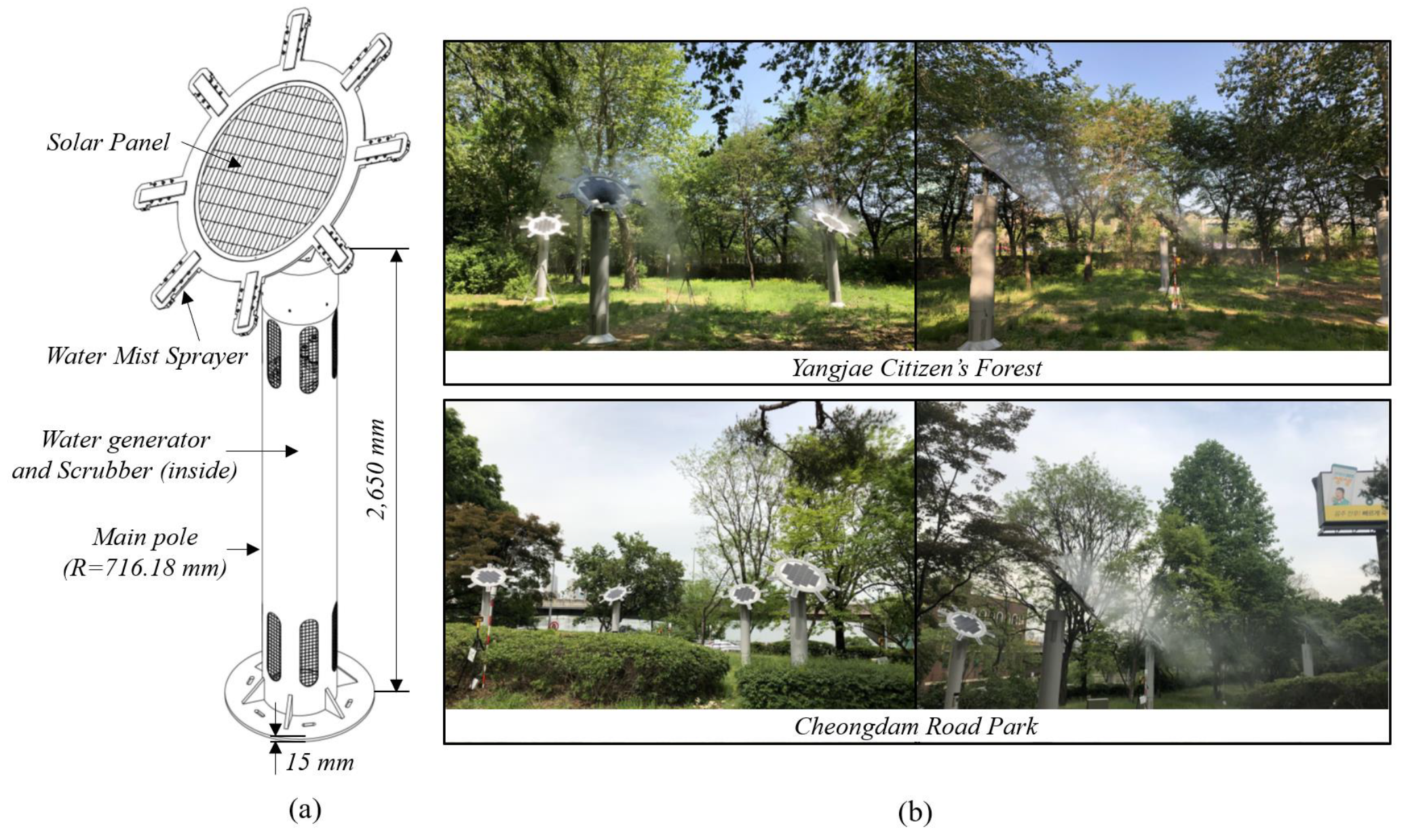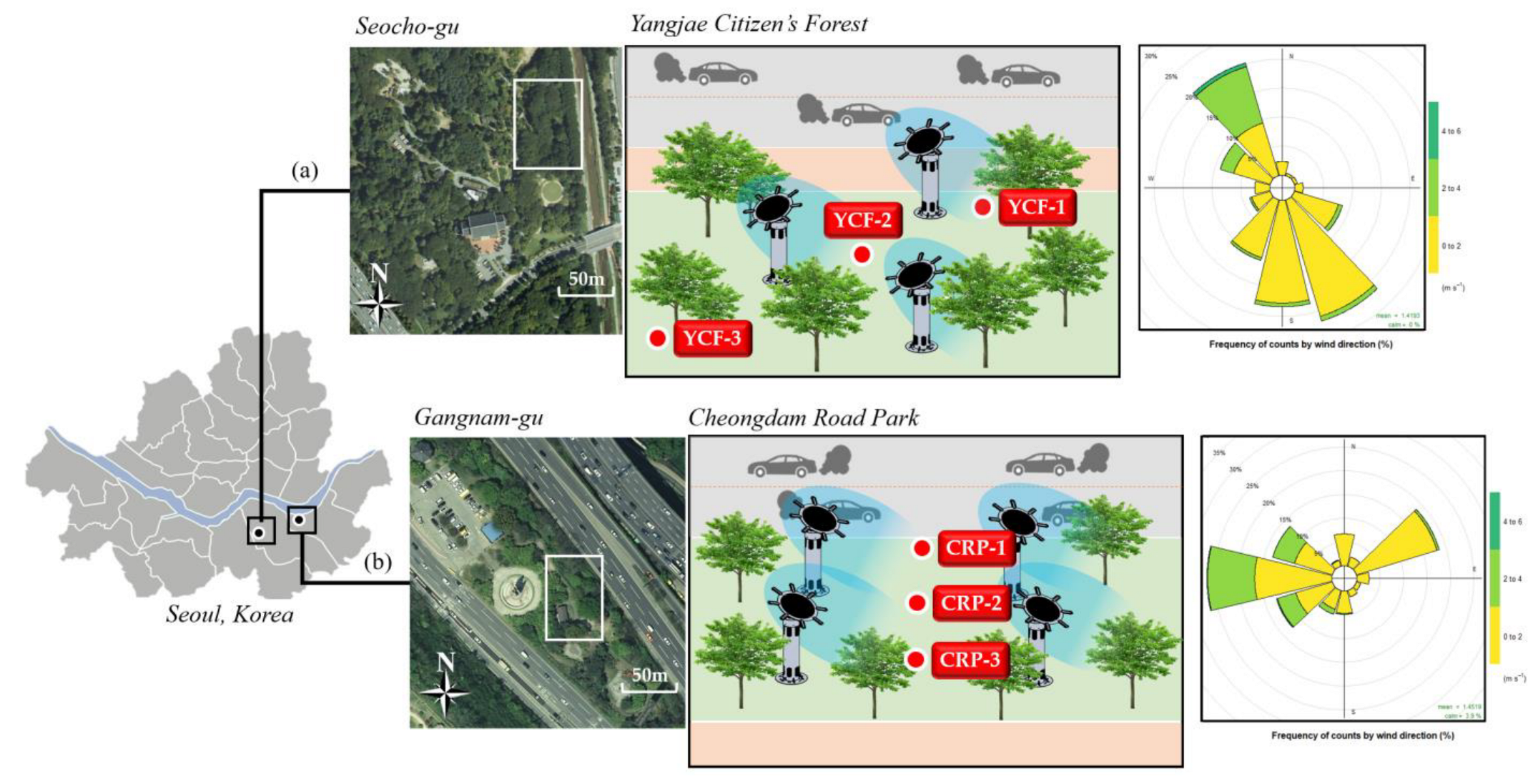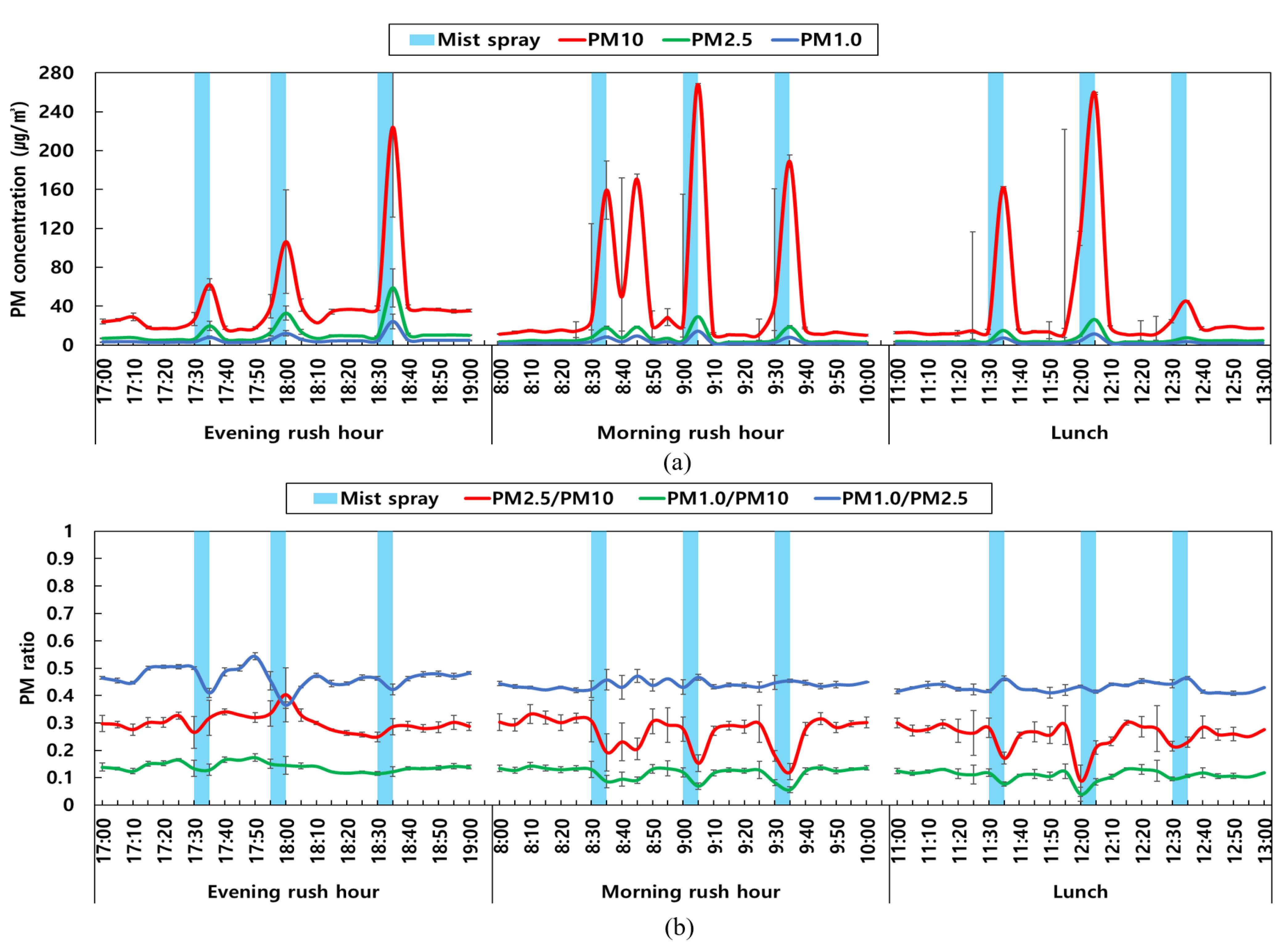An Application of Mist Generator as a Way to Reduce Particulate Matter during High Concentration Episodes in Urban Forests
Abstract
:1. Introduction
2. Materials and Methods
2.1. Mist Generator
2.2. Study Site
2.3. Measurement of PM and Weather Factors Based on Mist Spraying
2.4. Statistical Analysis
3. Results
3.1. Microclimate Conditions at the Study Site
3.2. Changes in PM According to Mist Spraying at YCF
3.3. Changes in PM According to Mist Spraying at CRP
4. Discussion
4.1. Microclimate Conditions According to Mist Spraying
4.2. Changes in PM According to Mist Spraying
5. Conclusions
- Mist spraying had significant effects on the concentration of PMx and the ratio of PM during a short time.
- This prototype of mist spraying could effectively condense and deposit the PM during high PM episodes.
- This device can be practically applied in an outdoor environment to diminish leaf burn damage by water droplets during sunny days.
Author Contributions
Funding
Institutional Review Board Statement
Informed Consent Statement
Data Availability Statement
Acknowledgments
Conflicts of Interest
References
- Jung, M.I.; Son, S.W.; Kim, H.C.; Kim, S.W.; Park, R.J.; Deliang, C. Contrasting synoptic weather patterns between non-dust high particulate matter events and Asian dust events in Seoul, South Korea. Atmos. Environ. 2019, 214, 116864. [Google Scholar] [CrossRef]
- Kim, J.; Kang, J.; Kim, H. Model design and demonstration test for the verification of temperature reduction effect cooling fog system with stainless steel. J. Environ. Sci. Int. 2020, 29, 683–689. [Google Scholar] [CrossRef]
- Davidson, C.I.; Phalen, R.F.; Solomon, P.A. Airborne particulate matter and human health: A review. Aerosol Sci. Technol. 2005, 39, 737–749. [Google Scholar] [CrossRef]
- Ysebaert, T.; Koch, K.; Samson, R.; Denys, S. Green walls for mitigating urban particulate matter pollution—A review. Urban For. Urban Green. 2021, 59, 127014. [Google Scholar] [CrossRef]
- Lelieveld, J.; Evans, J.S.; Fnais, M.; Giannadaki, D.; Pozzer, A. The contribution of outdoor air pollution sources to premature mortality on a global scale. Nature 2015, 525, 367–371. [Google Scholar] [CrossRef] [PubMed]
- Agudelo-Castañeda, D.M.; Teixeira, E.C.; Schneider, I.L.; Sheila, R.L.; Luis, F.O. Exposure to polycyclic aromatic hydrocarbons in atmospheric PM1.0 of urban environments: Carcinogenic and mutagenic respiratory health risk by age groups. Environ. Pollut. 2017, 224, 158–170. [Google Scholar] [CrossRef] [PubMed]
- Ma, T.; Duan, F.; He, K.; Qin, Y.; Tong, D.; Geng, G.; Liu, X.; Li, H.; Yang, S.; Ye, S.; et al. Air pollution characteristics and their relationship with emissions and meteorology in the Yangtze River Delta region during 2014–2016. J. Environ. Sci. (China) 2019, 83, 8–20. [Google Scholar] [CrossRef]
- Available online: https://eng.me.go.kr/eng/web/index.do?menuId=464 (accessed on 20 August 2024).
- Lovell, S.T.; Taylor, J.R. Supplying urban ecosystem services through multifunctional green infrastructure in the United States. Landsc. Ecol. 2013, 28, 1447–1463. [Google Scholar] [CrossRef]
- Andersson-Sköld, Y.; Klingberg, J.; Gunnarsson, B.; Kevin, C.; Ingela, G.; Marcus, H.; Igor, K.; Fredrik, L.; Åsa, O.S.; Håkan, P.; et al. A framework for assessing urban greenery’s effects and valuing its ecosystem services. J. Environ. Manag. 2018, 205, 274–285. [Google Scholar] [CrossRef] [PubMed]
- Matasov, V.; Marchesini, L.B.; Yaroslavtsev, A.; Giovanna, S.; Olga, F.; Ivan, S.; Simona, C.; Viacheslav, V.; Riccardo, V. IoT monitoring of urban tree ecosystem services: Possibilities and challenges. Forests 2020, 11, 775. [Google Scholar] [CrossRef]
- Nowak, D.J.; Crane, D.E.; Stevens, J.C. Air pollution removal by urban trees and shrubs in the United States. Urban For. Urban Green. 2006, 4, 115–123. [Google Scholar] [CrossRef]
- Escobedo, F.J.; Wagner, J.E.; Nowak, D.J.; De la Maza, C.L.; Rodriguez, M.; Crane, D.E. Analyzing the cost effectiveness of Santiago, Chile’s policy of using urban forests to improve air quality. J. Environ. Manag. 2008, 86, 148–157. [Google Scholar] [CrossRef] [PubMed]
- Shi, J.; Zhang, G.; An, H.; Yin, W.; Xia, X. Quantifying the particulate matter accumulation on leaf surfaces of urban plants in Beijing, China. Atmos. Pollut. Res. 2017, 8, 836–842. [Google Scholar] [CrossRef]
- Hofman, J.; Bartholomeus, H.; Janssen, S.; Kim, C.; Karen, W.; Shari, V.; Roeland, S. Influence of tree crown characteristics on the local PM10 distribution inside an urban street canyon in Antwerp (Belgium): A model and experimental approach. Urban For. Urban Green. 2016, 20, 265–276. [Google Scholar] [CrossRef]
- Leonard, R.J.; McArthur, C.; Hochuli, D.F. Particulate matter deposition on roadside plants and the importance of leaf trait combinations. Urban For. Urban Green. 2016, 20, 249–253. [Google Scholar] [CrossRef]
- McDonald, A.G.; Bealey, W.J.; Fowler, D.; Dragosits, U.S.; Smith, R.A.; Donovan, R.G.; Brett, H.E.; Hewitt, C.N.; Nemitz, E. Quantifying the effect of urban tree planting on concentrations and depositions of PM10 in two UK conurbations. Atmos. Environ. 2007, 41, 8455–8467. [Google Scholar] [CrossRef]
- Gugamsetty, B.; Wei, H.; Liu, C.N.; Awasthi, A.; Hsu, S.C.; Tsai, C.J.; Roam, G.D.; Wu, Y.C.; Chen, C.F. Source Characterization and Apportionment of PM10, PM2.5 and PM0.1 by Using Positive Matrix Factorization. Aerosol Air Qual. Res. 2012, 12, 476–491. [Google Scholar] [CrossRef]
- Terzaghi, E.; Wild, E.; Zacchello, G.; Bruno, E.L.C.; Kevin, C.J.; Antonio, D. Forest Filter Effect: Role of leaves in capturing/releasing air particulate matter and its associated PAHs. Atmos. Environ. 2013, 74, 378–384. [Google Scholar] [CrossRef]
- Wang, B.; Wei-kang, Z.; Niu, X.; Wang, X. Particulate matter adsorption capacity of 10 evergreen species in Beijing. Huan Jing Ke Xue= Huanjing Kexue 2015, 36, 408–414. [Google Scholar]
- Cregg, B.M.; Dix, M.E. Tree moisture stress and insect damage in urban areas in relation to heat island effects. J. Arboric. 2001, 27, 8–17. [Google Scholar]
- Fahey, R.T.; Bialecki, M.B.; Carter, D.R. Tree growth and resilience to extreme drought across an urban land-use gradient. Arboric. Urban For. 2013, 39, 279–285. [Google Scholar] [CrossRef]
- Zhao, S.P.; Yu, Y.; Yin, D.Y.; Qin, D.H. Contrasting response of ultrafine particle number and PM2.5 mass concentrations to Clean Air Action in China. Geophys. Res. Lett. 2021, 48, e2021GL093886. [Google Scholar] [CrossRef]
- Yamaguchi, M.; Izuta, T. Effects of Aerosol Particles on Plants. In Air Pollution Impacts on Plants in East Asia; Izuta, T., Ed.; Springer: Tokyo, Japan, 2017. [Google Scholar] [CrossRef]
- Katsoulas, N.; Bartzanas, T.; Boulard, T.; Mermier, M.; Kittas, C. Effect of vent openings and insect screens on greenhouse ventilation. Biosyst. Eng. 2006, 93, 427–436. [Google Scholar] [CrossRef]
- Li, S.; Willits, D.; Yunker, C. Experimental study of a high-pressure fogging system in naturally ventilated greenhouses. In Proceedings of the International Symposium on Greenhouse Cooling, Almería, Spain, 24–27 April 2006; Volume 719, pp. 393–400. [Google Scholar] [CrossRef]
- Arbel, A.; Yekutieli, O.; Barak, M. Performance of a fog system for cooling greenhouses. J. Agric. Eng. Res. 1999, 72, 129–136. [Google Scholar] [CrossRef]
- Available online: https://parks.seoul.go.kr (accessed on 20 August 2024).
- Available online: https://airkorea.or.kr (accessed on 20 August 2024).
- Wallace, L.A.; Wheeler, A.J.; Kearney, J.; Keth, V.; Hongyu, Y.; Ryan, H.K.; Pat, E.R.; Jeff, R.B.; Xiaohong, X. Validation of continuous particle monitors for personal, indoor, and outdoor exposures. J. Expo. Sci. Environ. Epidemiol. 2011, 21, 49–64. [Google Scholar] [CrossRef]
- Turnkey Instruments Ltd. Dustmate Operating Instructions. 2002. Available online: www.turnkey-instruments.com (accessed on 20 August 2024).
- Chen, J.; Yu, X.; Sun, F.; Xiaoxiu, L.; Yanlin, F.; Guodong, J.; Zhengming, Z.; Xuhui, L.; Li, M.; Huaxing, B. The concentrations and reduction of airborne particulate matter (PM10, PM2.5, PM1) at shelterbelt site in Beijing. Atmosphere 2015, 6, 650–676. [Google Scholar] [CrossRef]
- Wu, Y.; Liu, J.; Zhai, J.; Cong, L.; Wang, Y.; Ma, W.; Zhang, Z.; Li, C. Comparison of dry and wet deposition of particulate matter in near-surface waters during summer. PLoS ONE 2018, 13, e0199241. [Google Scholar] [CrossRef] [PubMed]
- McMurry, P.H.; Stolzenburg, M.R. On the sensitivity of particle size to relative humidity for Los Angeles aerosols. Atmospheric Environment 1989, 23, 497–507. [Google Scholar] [CrossRef]
- Yoo, S.Y.; Kim, T.H.; Ham, S.H.; Choi, S.M.; Park, C.R. Importance of urban green at reduction of particulate matters in Sihwa Industrial Complex, Korea. Sustainability 2020, 12, 7647. [Google Scholar] [CrossRef]
- Fan, H.; Zhao, C.; Yang, Y.; Yang, X. Spatio-Temporal Variations of the PM2.5/PM10 Ratios and Its Application to Air Pollution Type Classification in China. Front. Environ. Sci. 2021, 9, 692440. [Google Scholar] [CrossRef]
- Chon, Y.S.; Ha, S.H.; Jeong, K.J.; Choi, K.O.; Yun, J.G. Effect of mist treatment on the growth and quality of cut rose “Hanmaum” during summer. Korean J. Hortic. Sci. Technol. 2013, 31, 538–543. [Google Scholar] [CrossRef]
- Nam, S.W.; Kim, K.S.; Giacomelli, G.A. Improvement of cooling efficiency in greenhouse fog system using the dehumidifier. J. Bio-Environ. Control 2005, 14, 29–37, (In Korean with English Abstract). [Google Scholar]
- Sase, S.; Ishii, M.; Hayashi, M.; Sabeh, N.; Romero, P.; Giacomelli, G.A. Effect of natural ventilation rate on relative humidity and water use for fog cooling in a semiarid greenhouse. In Proceedings of the International Symposium on Greenhouse Cooling, Almería, Spain, 24–27 April 2006; Volume 719, pp. 385–392. [Google Scholar] [CrossRef]
- Egri, A.; Horváth, A.; Kriska, G.; Horváth, G. Optics of sunlit water drops on leaves: Conditions under which sunburn is possible. New Phytol. 2010, 185, 979–987. [Google Scholar] [CrossRef] [PubMed]
- Arbel, A.; Barak, M.; Shklyar, A. Combination of forced ventilation and fogging systems for cooling greenhouses. Biosyst. Eng. 2003, 84, 45–55. [Google Scholar] [CrossRef]
- Villarreal-Guerrero, F.; Kacira, M.; Fitz-Rodríguez, E.; Linker, R.; Kubota, C.; Giacomelli, G.A.; Arbel, A. Simulated performance of a greenhouse cooling control strategy with natural ventilation and fog cooling. Biosyst. Eng. 2012, 111, 217–228. [Google Scholar] [CrossRef]
- Kim, J.; Kim, W.; Kim, E. Analysis of temperature influence experiment on green spaces in campus. J. Korea Acad. Ind. Coop. Soc. 2020, 21, 511–520. [Google Scholar] [CrossRef]




| Measuring Time | Mist Spray | Yangjae Citizen’s Forest | Cheongdam Road Park | ||||
|---|---|---|---|---|---|---|---|
| Temperature | Relative Humidity | Wind Speed | Temperature | Relative Humidity | Wind Speed | ||
| -------°C------- | ----%---- | ----m/s---- | -----°C----- | ---%--- | ----m/s---- | ||
| Evening Rush hour | Before | 25.4 a (±0.2) | 26.8 a (±0.7) | 0.4 a (±0.0) | 24.4 a (±0.2) | 24.2 a (±0.9) | 0.5 a (±0.1) |
| During | 25.2 a (±0.3) | 27.9 a (±1.3) | 0.4 a (±0.0) | 24.2 a (±0.3) | 25.0 a (±1.3) | 0.5 a (±0.1) | |
| After | 25.0 a (±0.3) | 27.4 a (±1.5) | 0.4 a (±0.0) | 24.1 a (±0.2) | 24.8 a (±1.3) | 0.4 a (±0.1) | |
| Morning Rush hour | Before | 24.6 a (±0.2) | 18.4 a (±0.3) | 1.2 a (±0.1) | |||
| During | 24.6 a (±0.2) | 18.9 a (±0.4) | 1.3 a (±0.1) | ||||
| After | 24.7 a (±0.4) | 18.2 a (±0.4) | 1.2 a (±0.1) | ||||
| Lunch | Before | 23.3 a (±0.1) | 22.3 a (±0.2) | 1.4 a (±0.1) | 20.4 a (±0.3) | 14.4 a (±0.2) | 0.9 a (±0.1) |
| During | 23.2 a (±0.1) | 22.9 a (±0.4) | 1.3 a (±0.2) | 20.4 a (±0.3) | 14.8 a (±0.4) | 1.1 a (±0.1) | |
| After | 23.5 a (±0.2) | 22.6 a (±0.2) | 1.0 a (±0.2) | 20.8 a (±0.2) | 14.5 a (±0.4) | 1.0 a (±0.1) | |
| Time | Mist Spray | PM10 | PM2.5 | PM1.0 | PM2.5/PM10 | PM1.0/PM10 | PM1.0/PM2.5 |
|---|---|---|---|---|---|---|---|
| -----------------μg/m3------------------ | |||||||
| Evening Rush hour | Before | 27.0(±2.4) b | 8.4(±0.6) b | 4.3(±0.3) b | 0.33(±0.01) a | 0.17(±0.01) a | 0.51(±0.00) a |
| During | 53.7(±5.8) a | 21.0(±3.3) a | 9.1(±1.2) a | 0.39(±0.04) a | 0.18(±0.01) a | 0.46(±0.02) b | |
| After | 33.0(±3.7) b | 11.6(±1.4) b | 5.3(±0.5) b | 0.37(±0.02) a | 0.18(±0.01) a | 0.47(±0.01) ab | |
| Lunch | Before | 13.2(±0.5) b | 4.3(±0.1) b | 2.2(±0.0) b | 0.34(±0.01) a | 0.18(±0.01) a | 0.52(±0.00) a |
| During | 67.1(±22.1) a | 11.5(±1.5) a | 6.5(±0.7) a | 0.27(±0.02) b | 0.15(±0.01) a | 0.54(±0.00) a | |
| After | 14.2(±0.7) b | 4.2(±0.1) b | 2.2(±0.0) b | 0.32(±0.01) ab | 0.17(±0.00) a | 0.53(±0.00) a | |
| Time | Mist Spray | PM10 | PM2.5 | PM1.0 | PM2.5/PM10 | PM1.0/PM10 | PM1.0/PM2.5 |
|---|---|---|---|---|---|---|---|
| -----------------μg/m3------------------ | |||||||
| Evening Rush hour | Before | 23.9(±4.1) b | 6.9(±0.8) b | 3.4(±0.3) b | 0.30(±0.01) a | 0.15(±0.01) a | 0.49(±0.01) a |
| During | 82.9(±30.5) a | 23.4(±8.0) a | 9.6(±3.2) a | 0.31(±0.02) a | 0.13(±0.01) a | 0.44(±0.02) b | |
| After | 29.2(±4.6) b | 9.0(±1.4) b | 4.2(±0.6) b | 0.31(±0.01) a | 0.15(±0.01) a | 0.47(±0.01) a | |
| Morning Rush hour | Before | 16.9(±2.8) b | 4.8(±0.6) b | 2.1(±0.3) b | 0.30(±0.00) a | 0.13(±0.00) a | 0.44(±0.01) a |
| During | 117.1(±42.2) a | 13.9(±4.0) a | 6.4(±1.9) a | 0.21(±0.03) b | 0.09(±0.01) b | 0.45(±0.01) a | |
| After | 45.4(±25.8) b | 6.8(±2.5) b | 3.2(±1.3) b | 0.27(±0.02) a | 0.12(±0.01) a | 0.44(±0.01) a | |
| Lunch | Before | 12.7(±0.6) b | 3.5(±0.1) b | 1.5(±0.0) b | 0.27(±0.01) a | 0.12(±0.00) a | 0.43(±0.01) a |
| During | 102.4(±38.8) a | 11.1(±3.5) a | 5.0(±1.5) a | 0.20(±0.03) b | 0.09(±0.01) b | 0.44(±0.01) a | |
| After | 16.2(±1.3)b | 4.1(±0.2) b | 1.7(±0.1) b | 0.27(±0.01) a | 0.11(±0.00) a | 0.43(±0.00) a | |
Disclaimer/Publisher’s Note: The statements, opinions and data contained in all publications are solely those of the individual author(s) and contributor(s) and not of MDPI and/or the editor(s). MDPI and/or the editor(s) disclaim responsibility for any injury to people or property resulting from any ideas, methods, instructions or products referred to in the content. |
© 2024 by the authors. Licensee MDPI, Basel, Switzerland. This article is an open access article distributed under the terms and conditions of the Creative Commons Attribution (CC BY) license (https://creativecommons.org/licenses/by/4.0/).
Share and Cite
Yoo, S.-Y.; Kim, T.; Choi, S.; Park, C.-R.; Song, D.-H. An Application of Mist Generator as a Way to Reduce Particulate Matter during High Concentration Episodes in Urban Forests. Appl. Sci. 2024, 14, 9061. https://doi.org/10.3390/app14199061
Yoo S-Y, Kim T, Choi S, Park C-R, Song D-H. An Application of Mist Generator as a Way to Reduce Particulate Matter during High Concentration Episodes in Urban Forests. Applied Sciences. 2024; 14(19):9061. https://doi.org/10.3390/app14199061
Chicago/Turabian StyleYoo, Sin-Yee, Taehee Kim, Sumin Choi, Chan-Ryul Park, and Dong-Ha Song. 2024. "An Application of Mist Generator as a Way to Reduce Particulate Matter during High Concentration Episodes in Urban Forests" Applied Sciences 14, no. 19: 9061. https://doi.org/10.3390/app14199061








